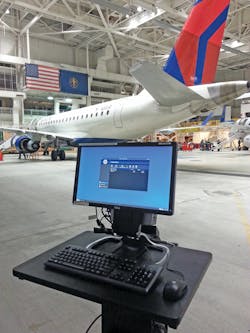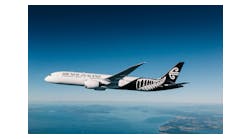There’s but one segment of the commercial airplane market due to take a dive between now and 2032 according to Boeing’s Current Market Outlook: regional jets. Where there were some 2,660 of them flying around in 2012, by 2032 the Outlook forecasts the flock at 2,180. And by the year 2032, a full 2,020 of them will be new airplanes.
That said, why are so many guys who specialize in regional aircraft MRO still smiling, still adding work – even amidst the exodus to the deep desert of legions of 50-seat ERJ-145s and smaller CRJs?
They’re making it because these innovative integrators have found their niche. Case-in-point: Bangor-based C&L Aerospace, whose man-hours are growing by about a third each year according to CEO Chris Kilgour.
Propjets and new airplanes
“We do a lot of turboprops here,” he says – Saab 340Bs and Dash-8s for the most part. The latter are particularly popular just now. Five to seven years ago, lots of them were parked. You could pick one up for a paltry million bucks. “Now,” says Kilgour, “you’re lucky to get one for $5 million.” He believes the same thing is about to happen to the Saab market. The reason, of course, is the cost of fuel. Propjets are inherently more fuel-efficient.
“The turboprop market is looking really [good],” agrees J.C. Tewfik, vice president sales and marketing for Montreal-based Discovery Air Technical Services. Discovery is heavily into Dash-8s, but made a strategic decision to expand into the ATR-42 and -72 lines because the airframer “is still offering fresh product.” They’ve also just begun to perform heavy maintenance on the Bombardier Q400. It’s a matter of positioning Discovery for future profits. The MRO isn’t doing a lot of work just yet on the Qs, “But … it gets our guys familiar with the aircraft,” says Tewfik. “We’re taking little bites, taking our time with the aircraft. We want to make sure the learning curve is as [gradual] as possible.”
While Tewfik doesn’t believe the 50-seat RJ market is altogether comatose, he concedes “nobody is picking up the … segment. There’s a void there.”
Embraer agrees. “There’s still going to be some good business out there for third parties [on the] Embraer 145,” contends Johann Bordais, Embraer’s vice president for services and support, commercial aviation. He says that while North American operators may be shedding their 50-seaters, areas such as Africa, Russia, and even Australia are flying the aircraft. “The market is still there,” he says. “It’s just shifting.”
That may be the case, but people like Kilgour and company continue to focus ferociously on propjets, skipping over the dwindling 50-seaters and setting their sights on working the emerging Embraer 170 and 190 market. That’s the strategy. The larger, passenger-popular Embraers “are going to be around for a long time,” he says. “The economics make sense.”
This sort of strategy makes sense to Oliver Wyman senior partner Tim Hoyland. “We’re in a dynamic period for the regionals,” says the consultant. That dynamic sees a substantial influx of larger new regional jets – Mitsubishi’s MRJ, Embraer’s E2, and Bombardier’s CSeries – by 2020. Those new airplanes carry with them ‘maintenance holidays’ attendant to most brand-new flying machines. For the operators, the overall move marks a shift from the care and feeding of an aging 50-seat fleet laced with what Hoyland calls “lots of maintenance, lots of required assets, and lots of inventory.”
Innovation, integration and self-sufficiency
That’s the big picture, the market as it’s foretold to unfold. But to take advantage of the opportunities of that market you’ve increasingly got to integrate, innovate, and perform as much work in-house as possible.
C&L Aerospace grew out of “the synergies” of melding two types of different business says Kilgour. His expertise in parts and aircraft trading combined with Telford Aviation Services’ experience in heavy maintenance combined to form a company better capable of competing in today’s integrated marketplace in which there’s a premium on supply chain, inventory management, and support.
One-stop-shopping is becoming as important in the regional MRO arena as it is with full-size narrowbodies and widebodies. A comparatively small company such as C&L (with approximately 140 employees) now operates its own interiors shop and paint hangar. It also keeps a pool of powerplants.
If breadth of offering is key, so too is the technology to execute it all. “If we could just keep working on an aircraft and repair things as we found them, that [would] make the repair go that much smoother,” says Kilgour. Problem is, of course, “we can’t. Customers need to have a say in the non-routine things we find.”
Typically, that means an operator representative on-site. That costs money. Virtual approval, repair approval from afar, “makes the process a lot smoother.” Take a photograph of the proposed fix, send it to the customer on the Internet, and nobody need break stride. As for customer pushback, Kilgour is surprised there hasn’t been any. “You’d have thought it would meet some resistance … But every customer we’ve introduced it to has loved it.”
Access is ascendant, both for the customer and the technician alike. Republic Airways Holdings is rolling out wireless computer carts in its maintenance bases across the country according to Scott Thien, the company’s manager of corporate communications. Republic is phasing in 10 of the carts at its Indianapolis hangar, rendering maintenance “much more efficient,” according to IND maintenance manager Tim Simpson. “We can look up the manual references and order repair parts needed without walking too far away [from the airplane] and getting distracted from the job in progress.”
Again, it’s a matter of not having to break stride, physically or mentally.
If what’s happening in Indy is an example of maintenance on the micro scale, Embraer’s emerging Scheduled Structural Health Monitoring (S-SHM) solution is decidedly macro in scope. In a written statement, the airframer contends S-SHM has the potential to “dramatically” reduce downtime and direct maintenance costs associated with complex, time-consuming structural inspections. Embraer says the system is being tested in collaboration with some carriers under real operational conditions. Here’s the essence of it: “traditional inspections would be replaced or enhanced” by the installation of sensor networks on the structures you want to monitor. During normal aircraft operation, the system is unpowered, activated only during maintenance checks. Embraer believes the net result of S-SHM is “conventional tasks that currently require several [man-hours] would be performed in minutes if no structural damage is detected.”
Up at Hyannis, on the coast of New England, at Cape Air & Nantucket Airlines, the aircraft of choice is the venerable Cessna 402C. The company has 72 of them, the largest fleet of the piston-powered type on the planet. With no replacement on the visible horizon, Jeffrey Schafer, the director of MRO and fleet programs, wants to sustain those airplanes for “the next 10 to 12 years.”
The 402C operator can afford to focus all its energies on maintaining its own airplanes. “We don’t take in outside maintenance,” says Trish Lorino, Cape Air & Nantucket Airlines’ vice president of marketing and public relations. The operator has its hands full “maintaining an aging fleet of aircraft which has been out of production [since 1985] and operated at a high rate of utilization in challenging environments.”
Schafer’s goal is conceptually simple, and continuingly challenging. “We want to control our own destiny with the airframe,” he says. With the exception of powerplant remanufacture he says, “All of our maintenance is performed in house.” That includes more back-shop work and avionics, things “we used to outsource.”
The move is more than philosophic. Because it fields a quintessentially legacy fleet, Schafer contends Cape Air & Nantucket Airlines “support from the OEM can become a little slower.” That’s why coming up with owner-produced parts and partnering with other industry players to develop STCs is so important.
An example of the latter is the operator’s work with Everett, WA-based AeroAcoustics Aircraft Systems to increase the gross landing weight of its 402Cs. The STC “allows us a little more flexibility in planning our routes,” says Schafer.
When your legacy legion of aircraft put in a high-cycle 72,500 flights hours annually, carrying some 620,000 passengers to 44 destinations arrayed across the United States, the Caribbean, and Micronesia flexibility is imperative.
Cape Air & Nantucket Airlines’ story may be at the extreme end of the definition of niche maintenance in today’s largely turbine environment. But the basics still apply: innovation, integration and – sometimes – as much in-house self-sufficiency as you can muster.





